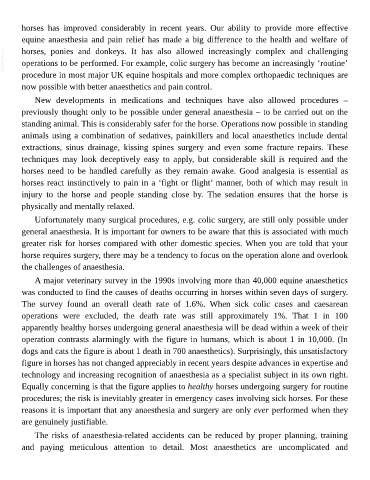Page 1087 - The Veterinary Care of the Horse
P. 1087
horses has improved considerably in recent years. Our ability to provide more effective
equine anaesthesia and pain relief has made a big difference to the health and welfare of
VetBooks.ir horses, ponies and donkeys. It has also allowed increasingly complex and challenging
operations to be performed. For example, colic surgery has become an increasingly ‘routine’
procedure in most major UK equine hospitals and more complex orthopaedic techniques are
now possible with better anaesthetics and pain control.
New developments in medications and techniques have also allowed procedures –
previously thought only to be possible under general anaesthesia – to be carried out on the
standing animal. This is considerably safer for the horse. Operations now possible in standing
animals using a combination of sedatives, painkillers and local anaesthetics include dental
extractions, sinus drainage, kissing spines surgery and even some fracture repairs. These
techniques may look deceptively easy to apply, but considerable skill is required and the
horses need to be handled carefully as they remain awake. Good analgesia is essential as
horses react instinctively to pain in a ‘fight or flight’ manner, both of which may result in
injury to the horse and people standing close by. The sedation ensures that the horse is
physically and mentally relaxed.
Unfortunately many surgical procedures, e.g. colic surgery, are still only possible under
general anaesthesia. It is important for owners to be aware that this is associated with much
greater risk for horses compared with other domestic species. When you are told that your
horse requires surgery, there may be a tendency to focus on the operation alone and overlook
the challenges of anaesthesia.
A major veterinary survey in the 1990s involving more than 40,000 equine anaesthetics
was conducted to find the causes of deaths occurring in horses within seven days of surgery.
The survey found an overall death rate of 1.6%. When sick colic cases and caesarean
operations were excluded, the death rate was still approximately 1%. That 1 in 100
apparently healthy horses undergoing general anaesthesia will be dead within a week of their
operation contrasts alarmingly with the figure in humans, which is about 1 in 10,000. (In
dogs and cats the figure is about 1 death in 700 anaesthetics). Surprisingly, this unsatisfactory
figure in horses has not changed appreciably in recent years despite advances in expertise and
technology and increasing recognition of anaesthesia as a specialist subject in its own right.
Equally concerning is that the figure applies to healthy horses undergoing surgery for routine
procedures; the risk is inevitably greater in emergency cases involving sick horses. For these
reasons it is important that any anaesthesia and surgery are only ever performed when they
are genuinely justifiable.
The risks of anaesthesia-related accidents can be reduced by proper planning, training
and paying meticulous attention to detail. Most anaesthetics are uncomplicated and

